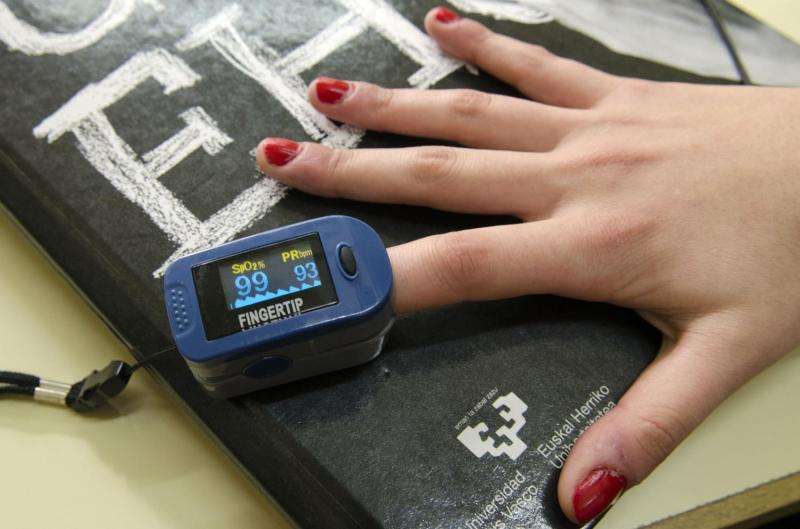Can the oxygen in the blood be measured if the nails have been painted?

When a patient is admitted to ED, one of the first clinical actions is to measure the concentration of oxygen in the blood by using a pulse oximeter positioned along the length of the nail. To prevent any possible interference, any nail varnish is removed. A study conducted by a multidisciplinary team led by a team of the UPV/EHU establishes that the alteration caused by nail varnish lies within the standard margin of error (± 2%) for pulse oximeters.
A pulse oximeter measures the oxygen saturation in the haemoglobin of the blood in a non-invasive way because it detects the different amount of light absorbed by the oxygenated and the deoxygenated haemoglobin in the systolic and diastolic phases. The sensors of the pulse oximeter are usually fitted to the fingernails, where nail varnish could distort the measurement. That is why during the clinical examination in an emergency situation, nail varnish is routinely removed to assess oxygen saturation. This process requires having available suitable nail varnish remover and a few seconds to carry it out. What is more, it may be necessary to obtain the consent of the person concerned in advance, which could lead to arguments with people who may refuse to have the varnish removed.
Traditionally, it has been thought that nail varnish could absorb the light emitted by the devices, interfere in the detection of the oxygenated haemoglobin, and influence the measurements that are made to ascertain oxygen saturation in the blood, one of the essential parameters in the clinical assessment of a patient. In order to establish the importance of this influence on the results of pulse oximetry, Sendoa Ballesteros and Irrintzi Fernández, lecturers in nursing at the UPV/EHU, analysed the data on 440 people who participated in 12 clinical trials carried out between January 1999 and February 2014 in the United States, Turkey, Brazil, Thailand, Italy and Germany. These trials were recorded in six of the most important databases in Health Sciences (Medline, Embase, WOS, Scopus, CINAHL and IBECS). Of the 440 cases studied, 50 were patients on respiratory support, 42 had chronic obstructive pulmonary disease (COPD), and five were healthy individuals who were subjected to a mild hypoxia simulation (low oxygen levels) caused by altitude (3,084 m). The remainder were healthy people who volunteered to take part in the study.
In this review carried out by the team led by Ballesteros and Fernández, there were found to be small differences in the results between the people who had painted nails and those who did not; in other words, the colour of the varnish influenced the statistical results of the measurement, but these variations detected were always less than 2%. They are therefore within the error margins of the pulse oximeters used and are of no significance in terms of clinical practice. It was, however, observed that dark colours (black, brown, blue and purple) tended to reduce the intensity of the signal and affect the performance of the pulse oximeter, yet no significant statistical differences were obtained between the different colours of the varnish nor in terms of the number of layers of varnish applied.
In the view of Sendoa Ballesteros, following the systematic review carried out on patients subjected to pulse oximetry, "although the varnish used for painting nails may affect the blood oxygen saturation reading, that slight alteration is not clinically relevant, in particular, when modern devices based on high-performance LED and sensor technology are used. Therefore, time should not be wasted in an effort to remove the nail polish during an emergency situation to obtain a valid oximetry measurement."
More information: Sendoa Ballesteros-Peña, Irrintzi Fernández-Aedo, Artzai Picón, Sergio Lorrio-Palomino: Influencia del esmalte de uñas en los valores de saturación de oxígeno en pacientes sometidos a pulsioximetría: una revisión sistemática (Influence of nail varnish on the oxygen saturation values in patients subjected to pulse oximetry; a systematic review). Emergencias 2015; 27.

















